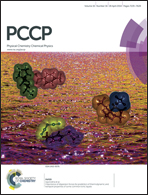The chemical origin and catalytic activity of coinage metals: from oxidation to dehydrogenation†
Abstract
The high oxidation activity of coinage metals (Cu, Ag and Au) has been widely applied in various important reactions, such as oxidation of carbon monoxide, alkenes or alcohols. The catalytic behavior of those inert metals has mostly been attributable to their size effect, the physical effect. In the present study, the chemical effects on their high oxidation activity have been investigated. We mechanistically examine the direct and oxidative dehydrogenation (partial oxidation) reactions of ethanol to acetaldehyde on a series of transition metals (groups 9, 10 and 11) with identical physical characteristics and varied chemical origins using density functional theory (DFT) calculations and electronic structure analyses at the GGA-PW91 level. The energetic results show that coinage metals have much lower activation energies and higher exothermicities for the oxidative dehydrogenation steps although they have higher energy for the direct dehydrogenation reaction. In the electronic structure analyses, coinage metals with saturated d bands can efficiently donate electrons to O* and OH*, or other electronegative adspecies, and better promote their p bands to higher energy levels. The negatively charged O* and OH* with high-lying p bands are responsible for lowering the energies in oxidative steps. The mechanistic understanding well explains the better oxidation activity of coinage metals and provides valuable information on their utilization in other useful applications, for example, the dehydrogenation process.


 Please wait while we load your content...
Please wait while we load your content...